Insulin Market Size
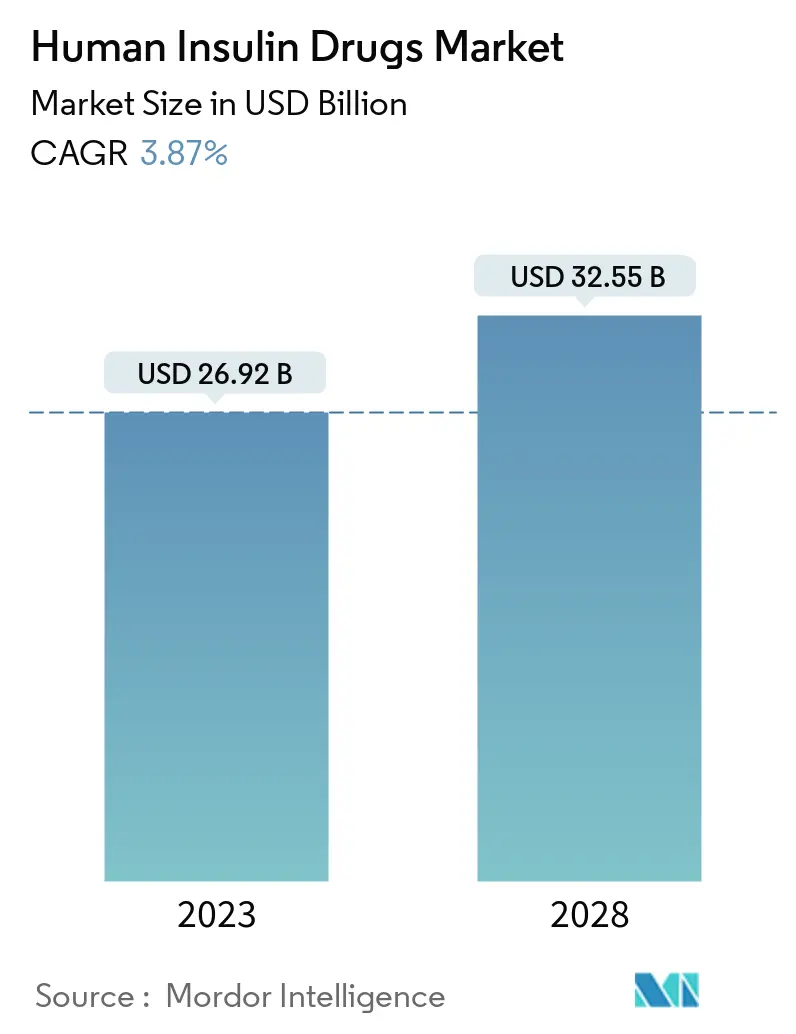
| Study Period | 2018 - 2028 |
| Market Size (2023) | USD 26.92 Billion |
| Market Size (2028) | USD 32.55 Billion |
| CAGR (2023 - 2028) | 3.87 % |
| Fastest Growing Market | North America |
| Largest Market | North America |
Major Players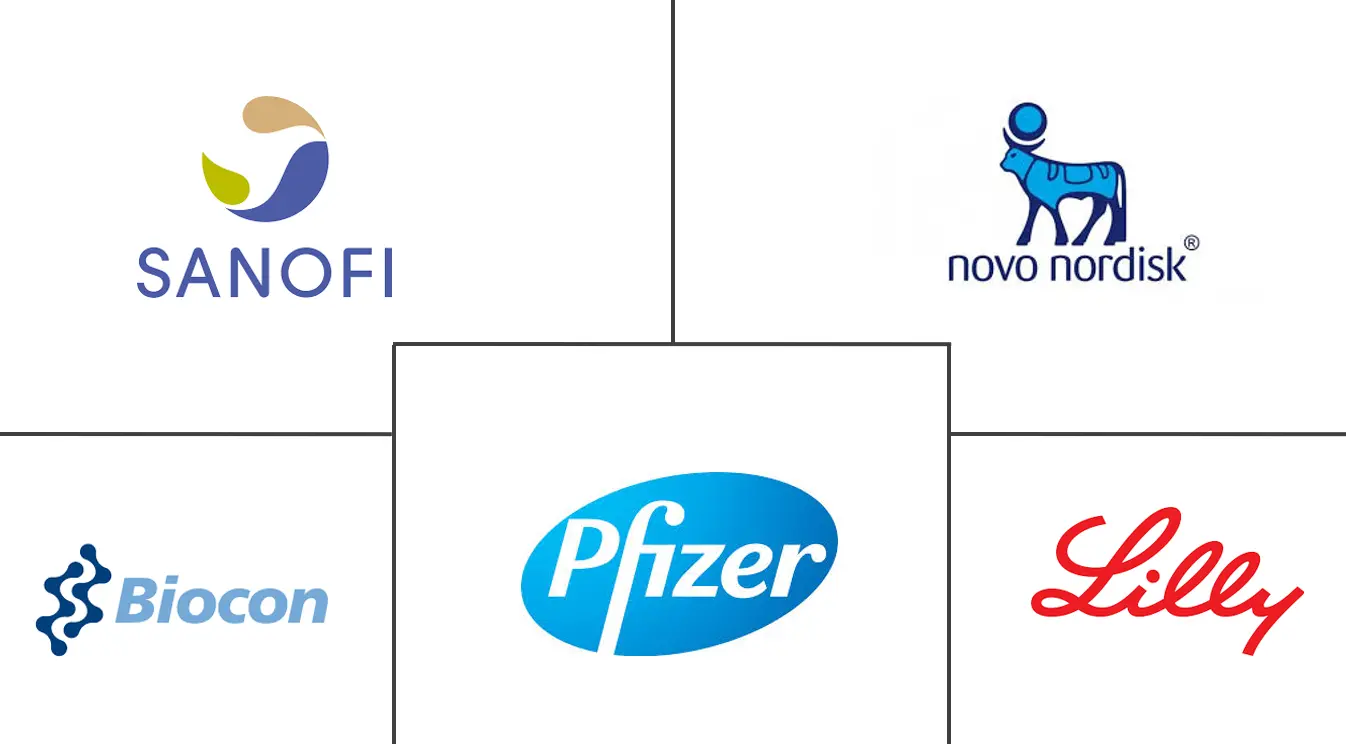
*Disclaimer: Major Players sorted in no particular order |
Need a report that reflects how COVID-19 has impacted this market and its growth?
Insulin Market Analysis
The Human Insulin Drugs Market size is estimated at USD 26.92 billion in 2023, and is expected to reach USD 32.55 billion by 2028, growing at a CAGR of 3.87% during the forecast period (2023-2028).
The COVID-19 pandemic has had a substantial impact on the Human Insulin Drugs Market. Type-1 diabetes patients are impacted more during Covid-19. People with diabetes are having a weak immune system so, with COVID-19, the immune system gets weaker very fast. People with diabetes will have more chances to get into serious complications rather than normal people.
Diabetes is associated with many health complications. People with diabetes have a 300% increased risk of being hospitalized compared to those without diabetes, and thus, they incur more healthcare expenses compared to non-diabetic people. Patients with Type 2 diabetes require many corrections throughout the day for maintaining nominal blood glucose levels, such as the administration of additional insulin or ingestion of additional carbohydrates. Furthermore, patients attempting to control their blood glucose levels, so as to prevent the long-term complications associated with fluctuations in blood glucose levels, are at greater risk for overcorrection and the resultant hypoglycemia.
Therefore, owing to the aforementioned factors the studied market is anticipated to witness growth over the analysis period.
Insulin Market Trends
Growing Diabetes Prevalence Driving the Market
All type-1 diabetes patients and a limited number of type-2 diabetes patients require daily insulin injections as part of their treatment. As per the ADA, around 67.3% of the cost of diabetes care in the United States is covered by government insurance (including Medicare, Medicaid, and the military). The rest is paid for by private insurance (30.7%) or by the uninsured (2%). In Canada, the total diabetic population in the country increased by approximately 33% between 2016 and 2022, and about 8% of the diabetic population has type-1 diabetes. Many developing countries in North America, including the Caribbean countries, are undergoing an epidemiologic transition and experiencing rapid increases in the prevalence of diabetes. As of 2022, the prevalence rates for diabetes ranged from 12% to 19% of the population in several countries in the region.
There was a glaring research gap in the absence of data for adult populations because only 1.52 million of the 8.75 million people with type-1 diabetes worldwide in 2022 were under the age of 20. If type-1 diabetes is not correctly diagnosed and promptly treated, it can lead to diabetic ketoacidosis, which can quickly result in death. Type-1 diabetes and the use of insulin were reported by 1.4 million individuals aged 20 or older, or 5.2% of all US adults with diagnosed diabetes, while 10.9% of all US adults with diagnosed diabetes, or 2.9 million adults aged 20 or older, started taking insulin within a year after diagnosis. Regular insulin is used along with a healthy diet and exercise routine to help diabetics with high blood sugar levels. Keeping blood sugar levels under control helps prevent kidney damage, blindness, nerve damage, limb loss, and issues with sexual function. Your chance of having a heart attack or stroke may be reduced if your diabetes is well controlled. This synthetic insulin is identical to human insulin. It takes the place of the insulin that your body typically produces. This insulin has a short half-life. It functions by making it easier for blood sugar (glucose) to enter cells where your body can use it as fuel. Usually, this drug is used with either a medium-acting or long-acting insulin product. The use of this medication with other oral diabetic medications is also possible.
Therefore, owing to the aforesaid factors, the growth of the studied market is anticipated.
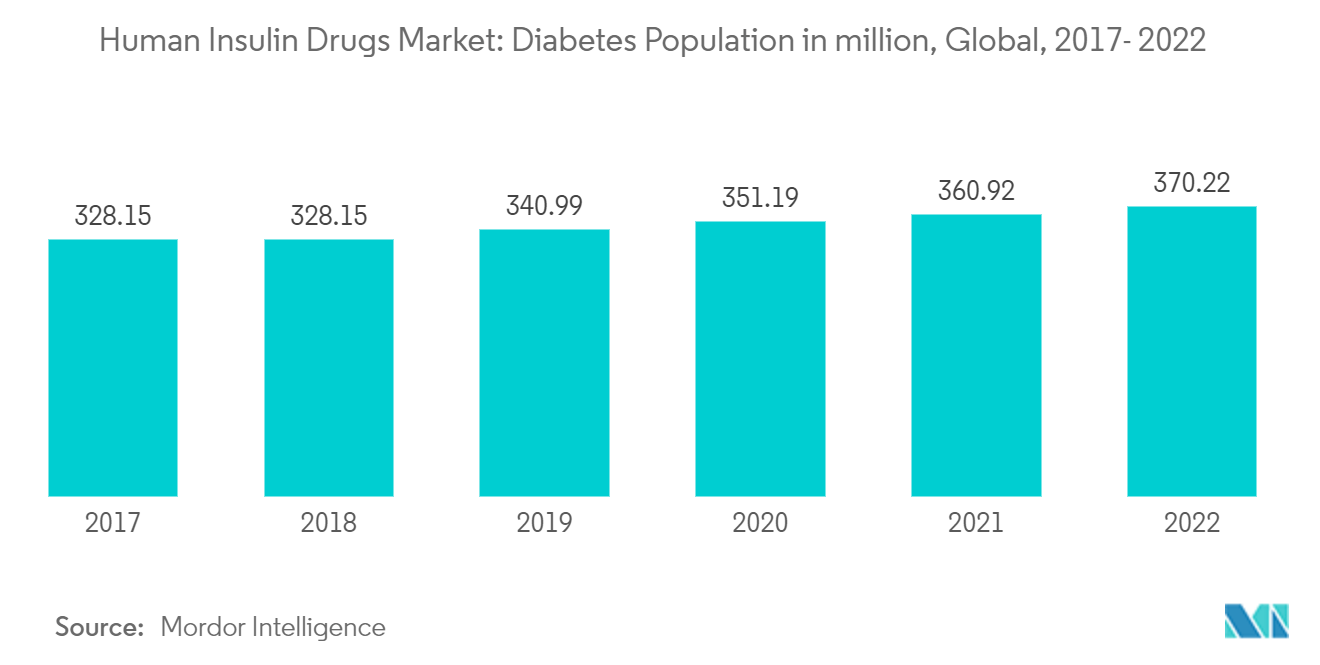
North America Dominates the Market
North America dominates the global human insulin market, especially the United States, owing to the high prevalence of diabetes in the region because of a sedentary lifestyle. The cost factor is the major concern in the United States, where almost 50% of the insulin revenues for the manufacturers are from the country itself. The United States accounts for the highest sales of long-acting insulin, Lantus, across the world. Most diabetic drug manufacturing companies consider the country a critical market for improving overall global sales. Lantus is the most commonly administered basal insulin across the world, accounting for a dominant share in the US market. The traditional North American human insulin drug market is expected to grow during the forecast period due to its affordability to patients. Humulin holds the highest market share, followed by Novolin. There are no generic competitors for the traditional North American human insulin drug market in the United States. The United States accounts for the highest sales of Humalog across the world, with over 56% of the market share. The majority of diabetes drug manufacturing companies consider the country a critical market for improving overall global sales. In the United States, Humalog is available in different varieties under names like Humalog Mix 75/25, Humalog U-100, Humalog U-200, and Humalog Mix 50/50 for the treatment of diabetes.
Therefore, owing to the aforesaid factors, the growth of the studied market is anticipated in the human insulin drug market.
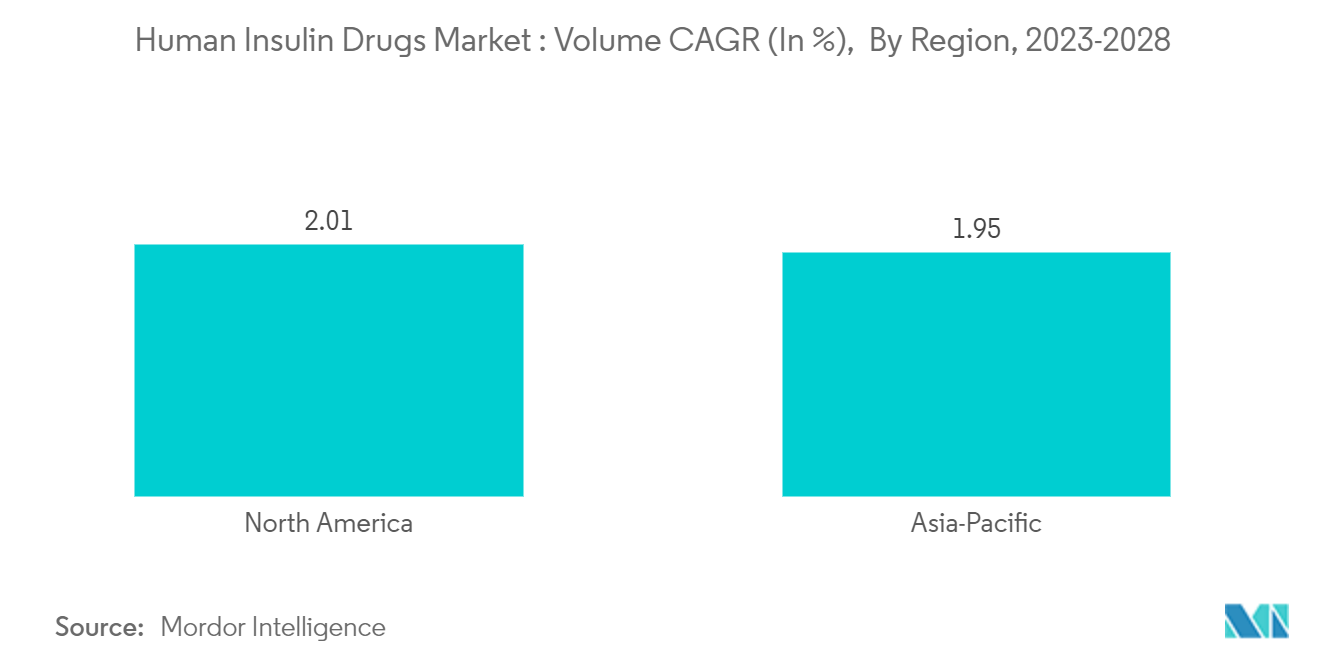
Insulin Industry Overview
The global human insulin market is highly consolidated, with three major manufacturers holding a global market presence and the remaining manufacturers confined to other local or region-specific manufacturers. Mergers and acquisitions that happened between the players in the recent past have helped the companies strengthen their market presence. Eli Lilly and Boehringer Ingelheim have an alliance to develop and commercialize Basaglar (Insulin Glargine). Biocon is developing Insulin Tregopil, an oral prandial insulin tablet, for the treatment of type-1 and type-2 diabetes mellitus. Fast-acting oral insulin could improve postprandial glucose control with reduced side effects and greater adherence, thus holding the promise to transform T1D management. Oramed Pharmaceuticals Inc., a clinical-stage pharmaceutical company focused on the development of oral drug delivery systems, is working to bring the first oral insulin product to market, thus providing a more convenient, effective, and safer method for delivering insulin therapy.
Insulin Market Leaders
Novo Nordisk A/S
Eli Lilly and Company
Sanofi S.A.
Biocon Limited
Pfizer Inc.
*Disclaimer: Major Players sorted in no particular order
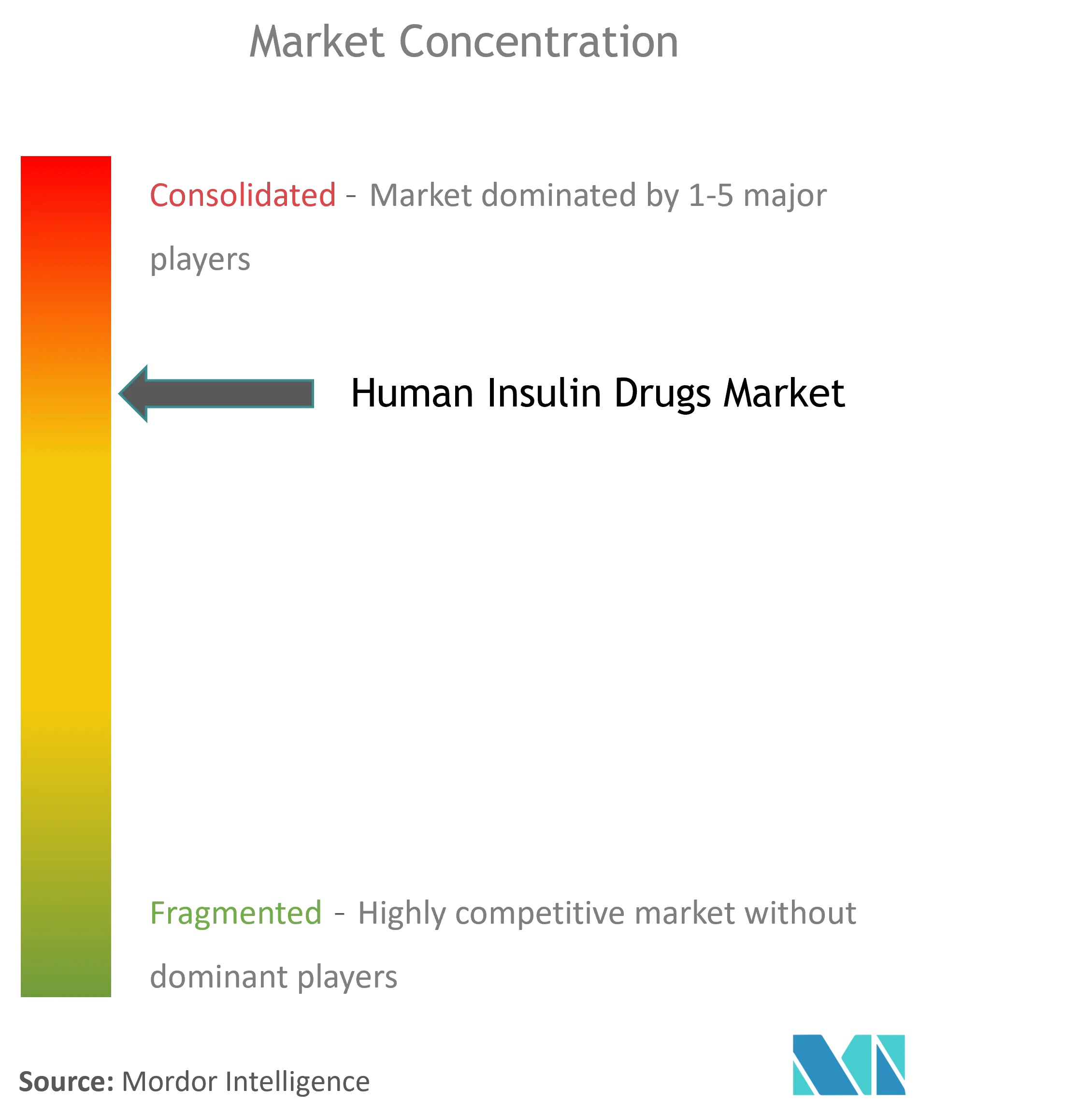
Insulin Market News
- November 2022: The U.S. Food and Drug Administration approved Tzield (teplizumab-mzwv) injection to delay the onset of stage 3 type-1 diabetics and pediatric patients 8 years of age and older who were stage 2 type-1 diabetics.
- May 2022: The FDA approved Lilly’s new medication Mounjaro (also known as tirzepatide) for type-2 diabetes management in addition to diet and exercise. This first-in-class medication showed improvement in glucose levels and also dramatically improved weight in clinical trials.
Insulin Market Report - Table of Contents
1. INTRODUCTION
1.1 Study Assumptions and Market Definition
1.2 Scope of the Study
2. RESEARCH METHODOLOGY
3. EXECUTIVE SUMMARY
4. MARKET DYNAMICS
4.1 Market Overview
4.2 Drivers
4.3 Restraints
4.4 Porter's Five Forces Analysis
4.4.1 Bargaining Power of Suppliers
4.4.2 Bargaining Power of Consumers
4.4.3 Threat of New Entrants
4.4.4 Threat of Substitute Products and Services
4.4.5 Intensity of Competitive Rivalry
5. MARKET SEGMENTATION
5.1 Product Type
5.1.1 Basal or Long-acting Insulins (Value and Volume, 2017 - 2028)
5.1.1.1 Lantus (Insulin glargine)
5.1.1.2 Levemir (Insulin detemir)
5.1.1.3 Toujeo (Insulin glargine)
5.1.1.4 Tresiba (Insulin degludec)
5.1.1.5 Basaglar (Insulin glargine)
5.1.2 Bolus or Fast-acting Insulins (Value and Volume, 2017 - 2028)
5.1.2.1 NovoRapid/Novolog (Insulin aspart)
5.1.2.2 Humalog (Insulin lispro)
5.1.2.3 Apidra (Insulin glulisine)
5.1.2.4 FIASP (Insulin aspart)
5.1.2.5 Admelog (Insulin lispro)
5.1.3 Traditional Human Insulins (Value and Volume, 2017 - 2028)
5.1.3.1 Novolin/Actrapid/Insulatard
5.1.3.2 Humulin
5.1.3.3 Insuman
5.1.4 Combination Insulins (Value and Volume, 2017 - 2028)
5.1.4.1 NovoMix (Biphasic Insulin aspart)
5.1.4.2 Ryzodeg (Insulin degludec/Insulin aspart)
5.1.4.3 Xultophy (Insulin degludec/Liraglutide)
5.1.4.4 Soliqua/Suliqua (Insulin glargine/Lixisenatide)
5.1.5 Biosimilar Insulins (Value and Volume, 2017 - 2028)
5.1.5.1 Insulin Glargine Biosimilars
5.1.5.2 Human Insulin Biosimilars
5.2 Geography
5.2.1 North America
5.2.1.1 United States (Value and Volume, 2017 - 2028)
5.2.1.1.1 Basal or Long-acting Insulins
5.2.1.1.2 Bolus or Fast-acting Insulins
5.2.1.1.3 Traditional Human Insulins
5.2.1.1.4 Combination Insulins
5.2.1.1.5 Biosimilar Insulins
5.2.1.2 Canada (Value and Volume, 2017 - 2028)
5.2.1.2.1 Basal or Long-acting Insulins
5.2.1.2.2 Bolus or Fast-acting Insulins
5.2.1.2.3 Traditional Human Insulins
5.2.1.2.4 Combination Insulins
5.2.1.2.5 Biosimilar Insulins
5.2.1.3 Rest of North America (Value and Volume, 2017 - 2028)
5.2.1.3.1 Basal or Long-acting Insulins
5.2.1.3.2 Bolus or Fast-acting Insulins
5.2.1.3.3 Traditional Human Insulins
5.2.1.3.4 Combination Insulins
5.2.1.3.5 Biosimilar Insulins
5.2.2 Europe
5.2.2.1 France (Value and Volume, 2017 - 2028)
5.2.2.1.1 Basal or Long-acting Insulins
5.2.2.1.2 Bolus or Fast-acting Insulins
5.2.2.1.3 Traditional Human Insulins
5.2.2.1.4 Combination Insulins
5.2.2.1.5 Biosimilar Insulins
5.2.2.2 Germany (Value and Volume, 2017 - 2028)
5.2.2.2.1 Basal or Long-acting Insulins
5.2.2.2.2 Bolus or Fast-acting Insulins
5.2.2.2.3 Traditional Human Insulins
5.2.2.2.4 Combination Insulins
5.2.2.2.5 Biosimilar Insulins
5.2.2.3 Italy (Value and Volume, 2017 - 2028)
5.2.2.3.1 Basal or Long-acting Insulins
5.2.2.3.2 Bolus or Fast-acting Insulins
5.2.2.3.3 Traditional Human Insulins
5.2.2.3.4 Combination Insulins
5.2.2.3.5 Biosimilar Insulins
5.2.2.4 Spain (Value and Volume, 2017 - 2028)
5.2.2.4.1 Basal or Long-acting Insulins
5.2.2.4.2 Bolus or Fast-acting Insulins
5.2.2.4.3 Traditional Human Insulins
5.2.2.4.4 Combination Insulins
5.2.2.4.5 Biosimilar Insulins
5.2.2.5 United Kingdom (Value and Volume, 2017 - 2028)
5.2.2.5.1 Basal or Long-acting Insulins
5.2.2.5.2 Bolus or Fast-acting Insulins
5.2.2.5.3 Traditional Human Insulins
5.2.2.5.4 Combination Insulins
5.2.2.5.5 Biosimilar Insulins
5.2.2.6 Russia (Value and Volume, 2017 - 2028)
5.2.2.6.1 Basal or Long-acting Insulins
5.2.2.6.2 Bolus or Fast-acting Insulins
5.2.2.6.3 Traditional Human Insulins
5.2.2.6.4 Combination Insulins
5.2.2.6.5 Biosimilar Insulins
5.2.2.7 Rest of Europe (Value and Volume, 2017 - 2028)
5.2.2.7.1 Basal or Long-acting Insulins
5.2.2.7.2 Bolus or Fast-acting Insulins
5.2.2.7.3 Traditional Human Insulins
5.2.2.7.4 Combination Insulins
5.2.2.7.5 Biosimilar Insulins
5.2.3 Latin America
5.2.3.1 Mexico (Value and Volume, 2017 - 2028)
5.2.3.1.1 Basal or Long-acting Insulins
5.2.3.1.2 Bolus or Fast-acting Insulins
5.2.3.1.3 Traditional Human Insulins
5.2.3.1.4 Combination Insulins
5.2.3.1.5 Biosimilar Insulins
5.2.3.2 Brazil (Value and Volume, 2017 - 2028)
5.2.3.2.1 Basal or Long-acting Insulins
5.2.3.2.2 Bolus or Fast-acting Insulins
5.2.3.2.3 Traditional Human Insulins
5.2.3.2.4 Combination Insulins
5.2.3.2.5 Biosimilar Insulins
5.2.3.3 Rest of Latin America (Value and Volume, 2017 - 2028)
5.2.3.3.1 Basal or Long-acting Insulins
5.2.3.3.2 Bolus or Fast-acting Insulins
5.2.3.3.3 Traditional Human Insulins
5.2.3.3.4 Combination Insulins
5.2.3.3.5 Biosimilar Insulins
5.2.4 Asia-Pacific
5.2.4.1 Japan (Value and Volume, 2017 - 2028)
5.2.4.1.1 Basal or Long-acting Insulins
5.2.4.1.2 Bolus or Fast-acting Insulins
5.2.4.1.3 Traditional Human Insulins
5.2.4.1.4 Combination Insulins
5.2.4.1.5 Biosimilar Insulins
5.2.4.2 South Korea (Value and Volume, 2017 - 2028)
5.2.4.2.1 Basal or Long-acting Insulins
5.2.4.2.2 Bolus or Fast-acting Insulins
5.2.4.2.3 Traditional Human Insulins
5.2.4.2.4 Combination Insulins
5.2.4.2.5 Biosimilar Insulins
5.2.4.3 China (Value and Volume, 2017 - 2028)
5.2.4.3.1 Basal or Long-acting Insulins
5.2.4.3.2 Bolus or Fast-acting Insulins
5.2.4.3.3 Traditional Human Insulins
5.2.4.3.4 Combination Insulins
5.2.4.3.5 Biosimilar Insulins
5.2.4.4 India (Value and Volume, 2017 - 2028)
5.2.4.4.1 Basal or Long-acting Insulins
5.2.4.4.2 Bolus or Fast-acting Insulins
5.2.4.4.3 Traditional Human Insulins
5.2.4.4.4 Combination Insulins
5.2.4.4.5 Biosimilar Insulins
5.2.4.5 Australia (Value and Volume, 2017 - 2028)
5.2.4.5.1 Basal or Long-acting Insulins
5.2.4.5.2 Bolus or Fast-acting Insulins
5.2.4.5.3 Traditional Human Insulins
5.2.4.5.4 Combination Insulins
5.2.4.5.5 Biosimilar Insulins
5.2.4.6 Vietnam (Value and Volume, 2017 - 2028)
5.2.4.6.1 Basal or Long-acting Insulins
5.2.4.6.2 Bolus or Fast-acting Insulins
5.2.4.6.3 Traditional Human Insulins
5.2.4.6.4 Combination Insulins
5.2.4.6.5 Biosimilar Insulins
5.2.4.7 Malaysia (Value and Volume, 2017 - 2028)
5.2.4.7.1 Basal or Long-acting Insulins
5.2.4.7.2 Bolus or Fast-acting Insulins
5.2.4.7.3 Traditional Human Insulins
5.2.4.7.4 Combination Insulins
5.2.4.7.5 Biosimilar Insulins
5.2.4.8 Indonesia (Value and Volume, 2017 - 2028)
5.2.4.8.1 Basal or Long-acting Insulins
5.2.4.8.2 Bolus or Fast-acting Insulins
5.2.4.8.3 Traditional Human Insulins
5.2.4.8.4 Combination Insulins
5.2.4.8.5 Biosimilar Insulins
5.2.4.9 Philippines (Value and Volume, 2017 - 2028)
5.2.4.9.1 Basal or Long-acting Insulins
5.2.4.9.2 Bolus or Fast-acting Insulins
5.2.4.9.3 Traditional Human Insulins
5.2.4.9.4 Combination Insulins
5.2.4.9.5 Biosimilar Insulins
5.2.4.10 Thailand (Value and Volume, 2017 - 2028)
5.2.4.10.1 Basal or Long-acting Insulins
5.2.4.10.2 Bolus or Fast-acting Insulins
5.2.4.10.3 Traditional Human Insulins
5.2.4.10.4 Combination Insulins
5.2.4.10.5 Biosimilar Insulins
5.2.4.11 Rest of Asia-Pacific (Value and Volume, 2017 - 2028)
5.2.4.11.1 Basal or Long-acting Insulins
5.2.4.11.2 Bolus or Fast-acting Insulins
5.2.4.11.3 Traditional Human Insulins
5.2.4.11.4 Combination Insulins
5.2.4.11.5 Biosimilar Insulins
5.2.5 Middle-East and Africa
5.2.5.1 Saudi Arabia (Value and Volume, 2017 - 2028)
5.2.5.1.1 Basal or Long-acting Insulins
5.2.5.1.2 Bolus or Fast-acting Insulins
5.2.5.1.3 Traditional Human Insulins
5.2.5.1.4 Combination Insulins
5.2.5.1.5 Biosimilar Insulins
5.2.5.2 Iran (Value and Volume, 2017 - 2028)
5.2.5.2.1 Basal or Long-acting Insulins
5.2.5.2.2 Bolus or Fast-acting Insulins
5.2.5.2.3 Traditional Human Insulins
5.2.5.2.4 Combination Insulins
5.2.5.2.5 Biosimilar Insulins
5.2.5.3 Egypt (Value and Volume, 2017 - 2028)
5.2.5.3.1 Basal or Long-acting Insulins
5.2.5.3.2 Bolus or Fast-acting Insulins
5.2.5.3.3 Traditional Human Insulins
5.2.5.3.4 Combination Insulins
5.2.5.3.5 Biosimilar Insulins
5.2.5.4 Oman (Value and Volume, 2017 - 2028)
5.2.5.4.1 Basal or Long-acting Insulins
5.2.5.4.2 Bolus or Fast-acting Insulins
5.2.5.4.3 Traditional Human Insulins
5.2.5.4.4 Combination Insulins
5.2.5.4.5 Biosimilar Insulins
5.2.5.5 South Africa (Value and Volume, 2017 - 2028)
5.2.5.5.1 Basal or Long-acting Insulins
5.2.5.5.2 Bolus or Fast-acting Insulins
5.2.5.5.3 Traditional Human Insulins
5.2.5.5.4 Combination Insulins
5.2.5.5.5 Biosimilar Insulins
5.2.5.6 Rest of Middle-East and Africa (Value and Volume, 2017 - 2028)
5.2.5.6.1 Basal or Long-acting Insulins
5.2.5.6.2 Bolus or Fast-acting Insulins
5.2.5.6.3 Traditional Human Insulins
5.2.5.6.4 Combination Insulins
5.2.5.6.5 Biosimilar Insulins
6. MARKET INDICATORS
6.1 Type-1 Diabetes Population (2017 - 2028)
6.2 Type-2 Diabetes Population (2017 - 2028)
7. COMPETITIVE LANDSCAPE
7.1 COMPANY PROFILES
7.1.1 Novo Nordisk A/S
7.1.1.1 Overview
7.1.1.2 Products and Strategies
7.1.1.3 Financial Benchmarking (Ratio Comparisons with Industry Standards)
7.1.1.4 Ratio Analysis (5 Years)
7.1.1.5 Strength and Stability Analysis (5 Years)
7.1.1.6 Recent Developments
7.1.2 Sanofi S.A.
7.1.2.1 Overview
7.1.2.2 Products and Strategies
7.1.2.3 Financial Benchmarking (Ratio Comparisons with Industry Standards)
7.1.2.4 Ratio Analysis (5 Years)
7.1.2.5 Strength and Stability Analysis (5 Years)
7.1.2.6 Recent Developments
7.1.3 Eli Lilly and Company
7.1.3.1 Overview
7.1.3.2 Products and Strategies
7.1.3.3 Financial Benchmarking (Ratio Comparisons with Industry Standards)
7.1.3.4 Ratio Analysis (5 Years)
7.1.3.5 Strength and Stability Analysis (5 Years)
7.1.3.6 Recent Developments
7.1.4 Biocon Limited
7.1.4.1 Overview
7.1.4.2 Products and Strategies
7.1.4.3 Financial Benchmarking (Ratio Comparisons with Industry Standards)
7.1.4.4 Ratio Analysis (5 Years)
7.1.4.5 Strength and Stability Analysis (5 Years)
7.1.4.6 Recent Developments
7.1.5 Pfizer Inc.
7.1.5.1 Overview
7.1.5.2 Products and Strategies
7.1.5.3 Financial Benchmarking (Ratio Comparisons with Industry Standards)
7.1.5.4 Ratio Analysis (5 Years)
7.1.5.5 Strength and Stability Analysis (5 Years)
7.1.5.6 Recent Developments
7.1.6 Wockhardt
7.1.6.1 Overview
7.1.6.2 Products and Strategies
7.1.6.3 Financial Benchmarking (Ratio Comparisons with Industry Standards)
7.1.6.4 Ratio Analysis (5 Years)
7.1.6.5 Strength and Stability Analysis (5 Years)
7.1.6.6 Recent Developments
7.1.7 Julphar
7.1.7.1 Overview
7.1.7.2 Products and Strategies
7.1.7.3 Recent Developments
7.1.8 Exir
7.1.8.1 Overview
7.1.8.2 Products and Strategies
7.1.8.3 Recent Developments
7.1.9 Sedico
7.1.9.1 Overview
7.1.9.2 Products and Strategies
7.1.9.3 Recent Developments
- *List Not Exhaustive
7.2 COMPANY SHARE ANALYSIS
7.2.1 Novo Nordisk AS
7.2.2 Sanofi Aventis
7.2.3 Eli Lilly
7.2.4 Other Companies
8. MARKET OPPORTUNITIES AND FUTURE TRENDS
Insulin Industry Segmentation
The hormone class of drugs includes human insulin. In place of the insulin that the body ordinarily produces, human insulin is used. It functions by assisting in the movement of blood sugar into different bodily tissues, where it is used as an energy source. It also prevents the liver from generating additional sugar. The human insulin drug market is set to register a CAGR of more than 3% during the forecast period. The human insulin drug market is segmented by product type (traditional human insulins, basal or long-acting insulins, bolus or fast-acting insulins, insulin combinations, and biosimilar insulins) and geography (North America, Europe, Asia-Pacific, the Middle East and Africa, and Latin America). The report offers the value (in USD million) and volume (in units million) for the above segments.
| Product Type | |||||||
| |||||||
| |||||||
| |||||||
| |||||||
|
| Geography | |||||||||||||||||||||||||||||||||||||||||||||||||||||||||||||||||||||||||||||||
| |||||||||||||||||||||||||||||||||||||||||||||||||||||||||||||||||||||||||||||||
| |||||||||||||||||||||||||||||||||||||||||||||||||||||||||||||||||||||||||||||||
| |||||||||||||||||||||||||||||||||||||||||||||||||||||||||||||||||||||||||||||||
| |||||||||||||||||||||||||||||||||||||||||||||||||||||||||||||||||||||||||||||||
|
Insulin Market Research FAQs
How big is the Human Insulin Drugs Market?
The Human Insulin Drugs Market size is expected to reach USD 26.92 billion in 2023 and grow at a CAGR of 3.87% to reach USD 32.55 billion by 2028.
What is the current Human Insulin Drugs Market size?
In 2023, the Human Insulin Drugs Market size is expected to reach USD 26.92 billion.
Who are the key players in Human Insulin Drugs Market?
Novo Nordisk A/S, Eli Lilly and Company, Sanofi S.A., Biocon Limited and Pfizer Inc. are the major companies operating in the Human Insulin Drugs Market.
Which is the fastest growing region in Human Insulin Drugs Market?
North America is estimated to grow at the highest CAGR over the forecast period (2023-2028).
Which region has the biggest share in Human Insulin Drugs Market?
In 2023, the North America accounts for the largest market share in the Human Insulin Drugs Market.
Insulin Industry Report
Statistics for the 2023 Insulin market share, size and revenue growth rate, created by Mordor Intelligence™ Industry Reports. Insulin analysis includes a market forecast outlook to 2028 and historical overview. Get a sample of this industry analysis as a free report PDF download.
